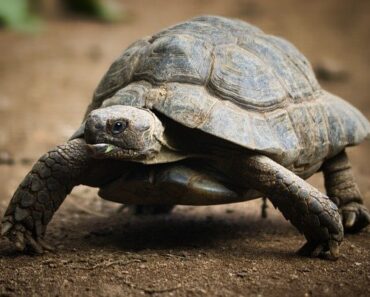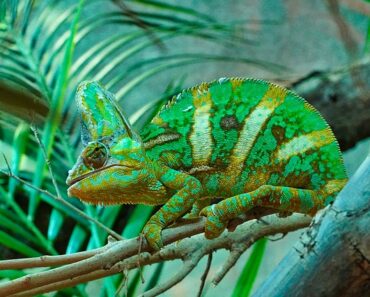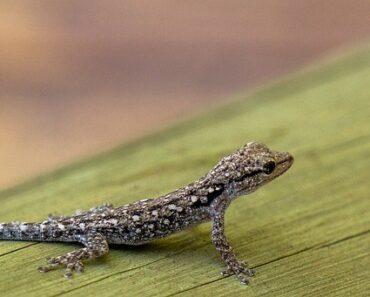
Want to adopt a lizard? These are often very popular with terrarists. And with good reason, rather docile, easily tamed, lizards are fascinating creatures to observe and handle. But then, which species to choose? What does a lizard eat? How do you set up your terrarium? We tell you everything about lizards and their needs.
Lizards: which species to choose?
If you are new to terrarium keeping, it is recommended that you start with a lizard that is known for its rather docile character and that it will be easier to tame.
If you are looking for a small lizard, the Leopard Gecko is a very good choice to start with. Measuring only about twenty centimeters, it is sociable, docile and easy to tame. The main difficulty lies in the permanent control of the temperature of its terrarium. As a nocturnal lizard, it needs a dry and rocky environment, with a warm zone between 30 and 32 °C and a cold zone at 28 °C. At night, the temperature should drop to 20 – 22 °C. It will also need hiding places, branches and rocks so that it can hide and not get bored.
The Australian Bearded Dragon, also called Pogona, is also a good option. This diurnal species of about forty centimeters is easy to handle and is particularly curious. Its terrarium should reproduce a desert biotope with a warm zone at 40 °C.
Finally, the Water Dragon will suit lovers of large lizards since it can measure from 60 to 90 centimeters. Very calm and sociable, it is also easy to handle. This arboreal species will require a large terrarium with many plants and branches, as well as an aquatic area.
In any case, be sure to gradually accustom your lizard to your scent by handling it for only a few minutes a day at first. Little by little you will be able to increase this time, but never make it too hard in order to limit the stress of your animal.
Animals from captive breeding are generally more docile, as they have been accustomed to humans from their first days.
What food should you feed your lizard?
Depending on its species, the lizard can have a herbivorous, omnivorous or carnivorous diet. The needs in proteins, carbohydrates and fats will be different, the contributions will not be made through the same food and the number of meals also varies according to the species and the age of your lizard:
Herbivorous lizards, like the iguana, feed exclusively on plants (fruits, vegetables, greens) at the rate of one meal per day for young lizards and one meal every two days for adult lizards;
Omnivorous lizards, such as the bearded dragon) will need animal proteins in addition to their vegetable intake (40% meat food for 60% vegetable). Most species require about 2 meals per week ;
Carnivorous lizards actually include 2 sub diets: insectivores and strict carnivores. Insectivorous lizards eat exclusively insects (butterflies, locusts, crickets, etc.) at a rate of one meal per day, whereas strict carnivorous lizards eat only small mammals and small vertebrates. Young lizards need one meal a day, while adults will settle for 2 meals a week.
Regardless of their diet, lizards will need calcium and vitamin supplements, as their food is very poorly supplied. Calcium and most of the vitamins can be provided through the use of special pellets, while vitamin D must be provided through a special terrarium lamp.
Finally, even if it is a cold-blooded animal, the lizard needs permanent access to a little water to hydrate itself, sometimes to bathe, and simply to keep a good level of humidity.
Which terrarium should you choose for your lizard and how should it be set up?
The choice of your terrarium will depend above all on the species of lizard you have chosen and its size once adult. Your vivarium should not be too large in order to remain adapted to the behavior of your lizard, but not too small either, because it will most certainly have to accommodate two temperature zones (one hot and one cold) and sometimes even an aquatic area. Ideally, try to choose a terrarium about 3 times longer than your lizard, and 1.5 times higher and deeper than it.
Indeed, the vivarium of your lizard will have to reproduce its living conditions in nature (desert, semi-desert or tropical) with the installation of a substrate on the ground, decorative elements (branches, rocks, roots, plants, etc.), and hiding places and shelters to rest or climb on. As always, try to find the right balance to make a vivarium that is neither too overloaded nor too empty. Don’t forget to place a bowl of water and remember to change it every day.
In addition to decoration, temperature and hygrometry management will be two particularly important parameters when creating your vivarium. Heating cable, heating plate or ceramic lamp, many terrarium heating options exist! You will also need to install UV lamps so that your lizard can synthesize vitamin D and calcium, essential for its survival.
Finally, make sure to place your terrarium in a quiet place, halfway up and without too much traffic to limit the stress on your reptile. Terrarium furniture is particularly suitable because it is perfectly adapted to different models of terrariums, can safely support the weight and guarantees stability for your terrarium. As a bonus, they usually include drawers or shelves to store your reptile’s accessories and food.






